In sustainable agriculture, farmers manage resources such as water, soil, and pests in ways that minimize environmental degradation and protect the long-term productivity of the land. In contrast, unsustainable agriculture is often characterized by practices that lead to the depletion of soil fertility, water contamination, and the loss of biodiversity.
Unsustainable agriculture is any type of farming that cannot be maintained in the long term. This can be due to a number of factors, such as soil depletion, water scarcity, and reliance on pesticides and synthetic fertilizers. Unsustainable agriculture often leads to environmental degradation, as well as social and economic problems.
What is an example of unsustainable agriculture?
Monoculture farming is a type of agriculture where a single crop is grown in large quantities on a piece of land. This type of farming can directly impair the land, reducing the amount of water and nutrients the soil can retain. This risks another Dust Bowl, as agriculture claims 80-90% of water use in the US. Monoculture farming has also depleted groundwater in parts of the Great Plains by up to 30%.
The industrial agriculture system is not sustainable. It consumes fossil fuel, water, and topsoil at unsustainable rates and contributes to numerous forms of environmental degradation, including air and water pollution, soil depletion, diminishing biodiversity, and fish die-offs.
What are the impacts of unsustainable agriculture
The unsustainability of current land management practices is a major contributor to the decline in productivity of land globally. Soil erosion and desertification are two of the most significant effects of unsustainable land management, and both can lead to significant reductions in crop yields and livestock productivity. In addition, unsustainability can exacerbate food insecurity, as forests provide food, inputs and services that support crop and livestock production. The FAO estimates that up to 30% of the world’s food production is at risk due to land degradation (FAO, 2006). Therefore, it is clear that sustainable land management practices are essential to food security and the productivity of land.
The practice of modern farming is ultimately not sustainable because the damage to the soil and natural ecosystems is so great that farming becomes dependent not on the land but on the artificial inputs into the process, such as fertilizers and pesticides. This damages the land even further and creates a vicious cycle that is difficult to break. In order to create a sustainable farming system, we need to find ways to reduce the damage to the land and create a more symbiotic relationship between the land and the farmer.
What are 5 unsustainable practices?
There are a number of unsustainable activities that we should start phasing out today in order to protect our planet and its resources. These include wasting food and water, buying one-use plastics, depending on fossil fuels, overpopulating cities, and contaminating resources. By taking steps to reduce or eliminate these activities, we can help to ensure a more sustainable future for all.
Something is sustainable if it can be maintained indefinitely. For example, a sustainable business model is one that can be maintained over the long term without damaging the environment or depleting resources. Something is unsustainable if it cannot be maintained indefinitely. For example, an unsustainable business model is one that is based on polluting the environment or depleting resources faster than they can be replaced.
What are examples of unsustainable?
Unsustainable development occurs when present progress is at the expense of future generations. For example, irresponsible planning and environmental degradation through exploitation of resources generates waste and pollution that damages ecosystems. Such practices are not sustainable in the long run and will have a negative impact on future generations.
According to a study by WWF, sugar is among the crops most harmful to the planet. Sugar plantations destroy the most biodiversity in the world by replacing habitats rich in animal, plant and insect life.
What crops are unsustainable
The least sustainable vegan foods are corn (because of fertilizer usage and monocropping), spinach (synthetic pesticides in non-organic farming), avocado (land and water usage), almond (water and fertilizer usage), and soybean (land usage). All of these foods require significant amount of resources to grow, and are often grown in ways that are not sustainable. For example, corn and soybeans are typically grown in large monocrops, which can lead to soil depletion and require large amounts of synthetic fertilizers. Spinach is often treated with synthetic pesticides, which can have negative impacts on the environment. Avocados require a lot of land and water to grow, and almonds require a lot of water and fertilizer. As veganism becomes more popular, it is important to be aware of the sustainability of our food choices.
The five root causes of unsustainable agricultural practices and degradation of the rural environment are: policy failure, rural inequalities, resource imbalances, unsustainable technologies, and trade relations. Intensification through specialization and diversification are two additional causes of these problems.
When did unsustainable agriculture start?
During the late 1800s and early 1900s, a booming economy and an abundance of fertile soil led to farmers rapidly expanding their agricultural lands and increasing crop production. Many of these farmers were new and inexperienced, excessively removing critical grasslands while planting in excess. This led to a number of problems, including topsoil erosion, water pollution, and loss of habitat for native plants and animals. In some cases, these problems were so severe that they contributed to the Dust Bowl of the 1930s.
There are many ways to protect and improve the quality of our soils, and farmers are increasingly adopting these practices. Reducing plowing, using cover crops and complex crop rotations, and planting deep-rooted plants are all ways to hold nutrients and water in the soil, while also providing habitat for wildlife and pollinators. By adopting these practices, we can help to ensure that our soils remain healthy and productive for years to come.
What are bad agriculture practices
Bad management practices in agriculture can lead to water pollution and negatively affect water quality. Poorly managed animal feeding operations, overgrazing, plowing, fertilizer, and improper, excessive, or badly timed use of pesticides can all contribute to water pollution. Pollutants from agriculture can be found in lakes, rivers, wetlands, estuaries, and groundwater, and can have a negative impact on the environment and human health.
Climate change is one of the most pressing issues of our time, and farmers must adapt to ensure the continued viability of their operations. Agriculture is a major contributor to climate change, accounting for 23% of greenhouse gas emissions. And with only 12% of the world’s land suitable for farming, and farming using 70% of the world’s fresh water, the need to sustainably manage our natural resources is critical. Biodiversity is also under threat, with agricultural expansion being a major driver of habitat loss. Therefore, it is essential that farmers take action to adapt to climate change and promote sustainable land management practices.
What is the most unsustainable industry?
The 7 biggest polluters by industry in 2022 will be ranked in new Energy (Electricity and Heating). Transport, Manufacturing and construction, Agriculture, Food retail, Fashion and Technology will continue to generate the majority of emissions. The total emissions for these industries will be 1583, 843, 63, 579, 31, 21 and 102 billion tons respectively.
Unsustainable refers to anything we cannot continue at its current rate. We use the term for debts, economic development, agricultural practices, and things we do that cause environmental damage.
Warp Up
Unsustainable agriculture is farmers practices that pioneer new frontiers without worrying about the environmental consequences. Deforestation, overgrazing, and monocropping are all examples of unsustainable agriculture. frontier is a line or border region, especially one recently opened up for settlement.
Sustainable agriculture is an approach to food production that is environmentally responsible, economically viable, and socially just. It is an approach that recognizes the interdependence of people, plants, animals, and the environment, and seeks to create a system in which all can flourish.





